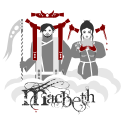





Adrienne made herself a rudimentary loom in order to complete the weaving on this leather mon!







Adrienne made herself a rudimentary loom in order to complete the weaving on this leather mon!
Toyohara Kunichika (1835-1900) One Hundred Roles of Baiko #90: The Ghost of Uto Yasukata, 1894. Oban. by Toshidama-Gallery on Flickr.
More inspiration for our Banquo. Perhaps we can work some red ribbon into his ghost over coat.



Initial costumes get a combat trial and pass!
The heron becomes a girl once more. Wonderful! Amazing quick change, and beautiful work.
—Stefania’s sketch detailing the articulated sheer hood for our apparitions.
Hannya, a Noh theatre mask representing a jealous female demon or serpent. Could be used as inspiration for the back of our witches.
Stefania has been hard at work! Here is one of her designs for our Lady Macbeth.

In a previous post I showed off Ryan’s work in progress. (He is making the crown for our kings.) The progress continues. AMAZING!
The head wrap might work nice for our nameless soldiers. (played by actors who are playing other named parts). Also, note the shoes! (Not that I’m expecting people to wear and fight in anything like that!)

The start of the crown! Ryan Consell (@studentOfWhim) got excited and started working. It looks amazing!





Mon (紋), also monshō (紋章), mondokoro(紋所), and kamon (家紋), are Japanese emblems used to decorate and identify an individual or family. While mon is an encompassing term that may refer to any such device, kamon and mondokoro refer specifically to emblems used to identify a family.
The devices are similar to the badges and coats of arms in European heraldic tradition, which likewise are used to identify individuals and families. Mon are often referred to as crests in Western literature; another European heraldic device similar to the mon in function.
Shears = good spooky.
(via nikaandherspace-blog)
Macbeth
Director:Jonathan C. Dietrich
All shows start at 8:00pm
 KWLT's 2013 production of Macbeth, directed by Jonathan C. Dietrich
KWLT's 2013 production of Macbeth, directed by Jonathan C. Dietrich